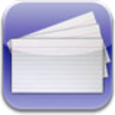
There haven’t been any new reviews for this site for quite some time. The decline in newly posted reviews coincides with my personal shift from using the OS X flash card program iFlash to using Anki, which is now my flashcard application of choice. I do hope to continue posting reviews here from time to time as I explore the new offerings that are out there, but I predict two busy years ahead of me finishing my PhD dissertation.
In a previous review of Anki, I had a number of critical things to say about the cross-platform application. However, I eventually came to realize that the only true advantage I seem to gain from using iFlash (a review of which I never completed for this site, out of a desire to wait for certain updates) were certain conveniences of the interface and its elegant Mac like feel.
Interfaces are important because they define the relationship between a user and his or her interaction with data. When done well, they also provide a sense of consistency which allow users to quickly and easily access the features that are useful to them but also create an enjoyment in the use of an application that bring users back again and again. Given the fact that, as a fully cross-platform application Anki must always make certain sacrifices in this regard and that it continues to have areas that might be seriously improved, I believe there will always be, at least in the OS X environment, a range of other flashcard applications which will appeal far more to a user at first use than what they are faced with when they first open the Anki application.
However, my reason for posting this entry today is to make and support the claim that Anki is currently and without question far ahead of all of its competition, at least in the OS X environment that I’m familiar with, as a powerful spaced repetition flashcard application.
I feel the need to post this entry because I’ve been sent a lot of e-mails by various students wanting me to stake a clear position on what I believe to be the current leading application. While the reviews on this website seem to be useful to many, the various advantages and disadvantages I have listed for each application in my various reviews seem to have left many newcomers to the world of spaced repetition and interval study in a flash card environment wondering what ultimately they ought to use.
So, for the record, after having looked at dozens of flash card applications on multiple platforms, many of which I have not had the time to review fully on this website, I am happy to recommend, without reservations, that’s serious students, especially of language study, take a good hard look at the open source and freely downloadable application Anki which is available for OS X, Windows, and Linux operating systems. I believe that given a little bit of initial effort in becoming familiar with the application and getting your data into the program either by direct input or through various import methods Anki provides the best solution for long-term memory management of large quantities of small atomic units of information. I am happy to endorse another application at some later date, and will continue to keep my eyes open for what is out there, but at this time, no other application, at least on the OS X platform, comes remotely close to Anki in terms of the number and power of features, flexibility in study, or implementation of spaced repetition.
Instead of writing a completely new updated review of Anki, below are listed just a few of the areas where I’ve been particularly impressed relative to the alternatives. Because I believe in the potential for further innovation through a healthy competition between flashcard applications I hope that other developers may consider some of the points below as they develop their own solutions. (Continued)

 iFlipr is one of the leading general purpose flashcard applications for iPhone/iPod which offers interval study and the recommended graded slideshow approach. I see great potential for this application. The clean and powerful web counterpart, in particular, is impressive, and the web centered approach may indicated a general direction for applications in the future.
iFlipr is one of the leading general purpose flashcard applications for iPhone/iPod which offers interval study and the recommended graded slideshow approach. I see great potential for this application. The clean and powerful web counterpart, in particular, is impressive, and the web centered approach may indicated a general direction for applications in the future.
Flip Fixation Flaw
I’ve decided to coin a new term to describe an issue I see in many flashcard applications and web sites. I have argued with developers over email and in comments about this issue but it is one I feel strongly about:
A flashcard application is said to be guilty of the Flip Fixation Flaw when the developer’s attempt to emulate the experience of studying and flipping a physical flashcard comes at the cost to the student of time or software functionality.
In principle, there is nothing wrong with creating a digital flashcard experience within educational software which is modeled upon the original physical paper based flashcard. This only becomes a problem when the marginal benefit of this approach is outweighed by the cost in terms of speed, space, and visual experience.
It’s Not Just about the Flipping
The three most common ways developers commit the flip fixation flaw are:
Lost Speed – When there is a non-trivial amount of time wasted upon creating the visual experience of “flipping” a digital flashcard to show another side of the card or sweep the card off the screen to show the next card. Because reviewing a well-studied flashcard can take less than a second, anything but the fastest flip animations can easily double the time it takes for a student to study a medium to high volume of flashcards.
If developers really want to flip the cards, then please: flip’em really fast!
Lost Space – In order to further give the user the impression they are looking at a physical card, developers often draw an image of a rounded or regular rectangle on the screen in which the content of the card is displayed and upon which the flip action is performed. This is a terrible waste of screen real estate because both the card and sometimes dozens of precious pixels are being wasted that might have been better put to slave labor portraying bigger fonts or more text.
Even if you want to “flip” the digital flashcard, we don’t need to waste screen space on a cute little flashcard, just flip the whole screen or canvas on the window.
Lost Memories – Some developers, who apparently really miss the real thing, like to create flashcards which reproduce the red vertical line and blue horizontal lines on ancient paper flaschards and elementary school notebooks.
Get over it, move on! Are you worried the users are going to type out of line or off the left margin? It may spark moments of nostalgia for people like myself who have actually used the brand of physical flashcards that looked like this, but no, we really don’t want to stare at the blue and red lines when we practice our flashcards.